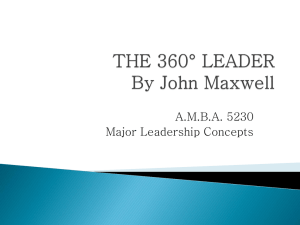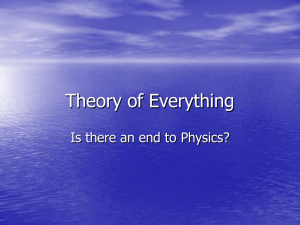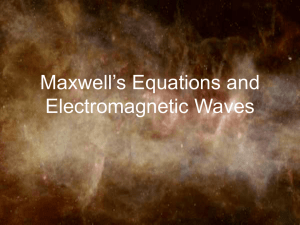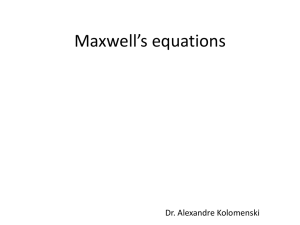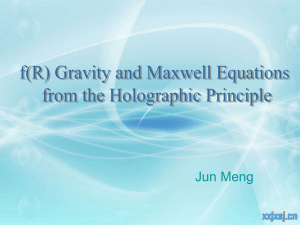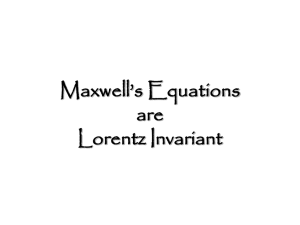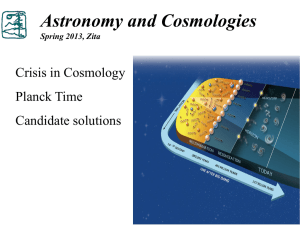Polchinski-Hertz - Quantum Field Theory: Developments and
advertisement
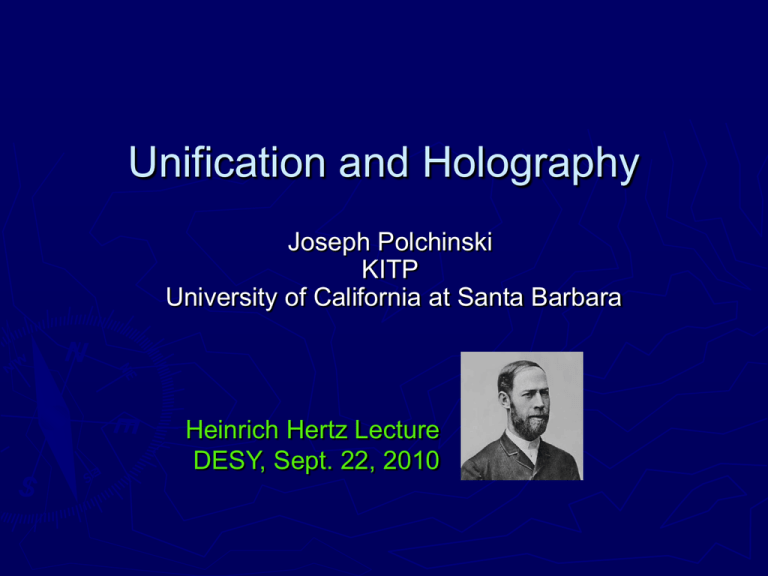
Unification and Holography Joseph Polchinski KITP University of California at Santa Barbara Heinrich Hertz Lecture DESY, Sept. 22, 2010 Heinrich Hertz Experimental discovery of electromagnetic waves, 1887 Heinrich Hertz Experimental discovery of electromagnetic waves, 1887 James Maxwell Theoretical prediction of electromagnetic waves, 1862 Maxwell’s equations: Maxwell’s equations: Coulomb: charges make electric fields (1783) Ampere: currents make magnetic fields (1826) Faraday: changing magnetic fields make electric fields (1831) Maxwell: changing electric fields make magnetic fields (1861) How Maxwell did it Mathematical consistency: without Maxwell’s term the different equations make different predictions. They work fine for a constant current, battery + current X How Maxwell did it Mathematical consistency: without Maxwell’s term the different equations make different predictions. They work fine for a constant current, battery + X current switch but fail if the current is suddenly changed. In 1861 this was just a thought experiment, because things would happen too fast to be observed. How Maxwell did it He also used physical models, and effective field theory. How Maxwell did it Adding Maxwell’s term fixed everything X How Maxwell did it Adding Maxwell’s term fixed everything, and gave an unexpected bonus: Faraday Maxwell magnetic electric magnetic electric magnetic electric ... = electromagnetic wave speed = 1/m 0e0 = speed of light (to few % accuracy) How Maxwell did it • Maxwell’s reasoning, and results, have a tremendous ring of truth today. But remarkably, they were unappreciated in his lifetime. • The notion of fields E(x,t) and B(x,t) was too new. Today, they are the basic principle underlying all of physics. • Maxwell’s work was not well understood, and other less complete theories competed, until Hertz. E(x,t) or B(x,t) How Maxwell did it • Maxwell’s reasoning, and results, have a tremendous ring of truth today. But remarkably, they were unappreciated in his lifetime. • The notion of fields E(x,t) and B(x,t) was too new. Today, they are the basic principle underlying all of physics. • Maxwell’s work was not well understood, and other less complete theories competed, until Hertz. Hertz • Reached the high frequency (100 MHz) regime by driving a resonant circuit with sparks, observed electromagnetic waves, and figured out what he was seeing. Hertz • Reached the high frequency (100 MHz) regime by driving a resonant circuit with sparks, observed electromagnetic waves, and figured out what he was seeing. • Was also a theorist: put Maxwell’s equations in modern form. Hertz Diary excerpt (1884): 20 October: Thought anxiously about electomagnetics 24 October: Turned back to electromagnetics 25 October: Thought about electromagnetics 29 October: Very bad mood Hertz • Reached the high frequency (100 MHz) regime by driving a resonant circuit with sparks, observed electromagnetic waves, and figured out what he was seeing. • Was also a theorist: put Maxwell’s equations in modern form. • Was determined to discover new phenomena. • Due to the work of Maxwell and Hertz, the field idea began to take its central role in physics. • Today we are trying to repeat for quantum mechanics and gravity what Maxwell did for electricity, magnetism, and light, uniting them into a single theory. • We know a lot, and we hope to figure out the remaining pieces. • Like Maxwell, we are heavily reliant on theoretical arguments such as thought experiments. • The problem goes back to Planck… Max Planck Discovered black body radiation law (1900): first quantum law. Combined fundamental constants of special relativity (c), general relativity - to get: (G), and quantum mechanics (h) 3 = 1.6 x 10-33 cm = L Planck length: √hG/c P 5 = 5.4 x 10-44 sec = T Planck time: √hG/c P The first quantum gravity equations Max Planck Discovered black body radiation law (1900): first quantum law. Combined fundamental constants of special relativity (c), general relativity - to get: (G), and quantum mechanics (h) 3 = 1.6 x 10-33 cm = L Planck length: √hG/c P 5 = 5.4 x 10-44 sec = T Planck time: √hG/c P The first quantum gravity equations (1899!) Max Planck “These [units] necessarily retain their meaning for all times and for all civilizations, even extraterrestrial and non-human ones, and can therefore be designated as natural units.” Planck length: 1.6 x 10-33 cm = LP Planck time: 5.4 x 10-44 sec = TP Main point: this length and time are incredibly small, far beyond the reach of direct experiment. Recall Hertz: 10-8 sec; LHC: 10-29 sec. So we will need to use theoretical tools, such as thought experiments, as Maxwell did. Some key thought experiments: • Gravitational scattering • The string in a small box • Black hole thought experiments: • Entropy • Information • Black holes & D-branes I. Gravitational scattering: Imagine two electrons scattering via the gravitational interaction: virtual graviton e- e- This is a very small effect, ~ LP2. Hence, a thought experiment. Now look at an even smaller effect: graviton Next term: two virtual gravitons: graviton e- Result: twice as small, ~ LP4, but times ! e- The problem comes when all the interactions are close together: `Nonrenormalizable’ Another way to think about this: general relativity + quantum mechanics give rise to `spacetime foam’ at very short distances: • Such problems have appeared before. • They usually indicate that one’s theory is wrong at small distance and must be `smeared out’ in some way. • It is not easy to do this without violating some other principle, so the ’s are actually valuable clues to the correct theory. Example: The Weinberg-Salam theory of the weak interactions: ne nm ne nm W e m e m The W and Z bosons, and their properties, were predicted before they were seen. • For gravity, adding a few new particles does not seem to be enough. • What seems to work is to replace the pointlike gravitons and electrons with one-dimensional strings: . point loop or strand • This is strange idea, with a strange history, but it seems to work. The scattering processes get fattened out: Point: String: This may not be the only way to cure the ’s, but like Maxwell’s equations I believe it has the ring of truth. II. The string in a box: Strings were an unfamiliar idea, and many thought experiments have been useful in understanding their physics. Here’s one: ? Put string loops in a closed (periodic) space Make the space smaller...and smaller The mathematics gets interesting, and leads to a surprising picture: ? = ! When the original space goes away, a new large space emerges. This is due to `winding strings,’ which become more numerous when the box is smaller. `T-duality.’ Lessons: stringy geometry, emergent space, minimum length. That was for a closed string open string : . Now try it for an ? Put a string in a finite space Make the space smaller...and smaller Again, the trick is to figure out what is the physical picture that emerges from the math, and the answer is unexpected: ? = ! • The emergent space also contains a new object, a `Dirichlet-brane,’ (D-brane) with a number of interesting properties (JP, Dai, Leigh, Horava, Green). • This greatly expands and deepens string theory, much as Maxwell’s term expanded and deepened E&M. • Unlike Maxwell, we are not yet finished. On to the next thought experiment! III. The Evaporating Black Hole: 2. Black hole formation time 1. Initial state: infalling matter horizon 3. Black hole evaporation singularity 4. Final state: Hawking radiation Make a black hole and watch it evaporate. First conclusion (Bekenstein, Hawking): black holes satisfy laws of thermodynamic with an entropy proportional to their horizon area. This thermodynamics should come from counting states in statistical mechanics. I.e. it suggests that black holes have an atomic structure with Planck sized `atoms’ on their surface: G. ‘t Hooft Second conclusion (Hawking): this process destroys information. What comes out doesn’t depend on what fell in. (More precisely, pure states evolve to mixed states). This implies a big change to the mathematics of quantum mechanics, which probably leads to bad consequences. But the alternative seems even more extreme: to save quantum mechanics we must radically change the nature of spacetime. The black hole entropy and information puzzles suggest the holographic principle: The fundamental laws of quantum gravity must be formulated, not in terms of local fields similar to E(x,t) and B(x,t), but in terms of bits that live outside the region being looked at, on its boundary. G. ‘t Hooft The black hole entropy and information puzzles suggest the holographic principle: The fundamental laws of quantum gravity must be formulated, not in terms of local fields similar to E(x,t) and B(x,t), but in terms of bits that live outside the region being looked at, on its boundary. ? A big change, if it is true. ? G. ‘t Hooft IV. Black holes and D-branes: Another thought experiment (Strominger & Vafa): in string theory, we can imagine gradually making gravity weaker, so the black hole is no longer black, and see what’s `inside.’ For the simplest black holes it’s D-branes, and these give a precise count of the states. By further thought experiments with this Maldacena realized much more: the D-branes holographically reconstruct the spacetime near the black hole. By further thought experiments with this Maldacena realized much more: the D-branes holographically reconstruct the spacetime near the black hole. Moreover, the degrees of freedom on the boundary are gauge fields, similar to those that describe the strong interaction. An unexpected unity in physics: gravity = gauge theory By further thought experiments with this Maldacena realized much more: the D-branes holographically reconstruct the spacetime near the black hole. Moreover, the degrees of freedom on the boundary are gauge fields, similar to those that describe the strong interaction. An unexpected unity in physics: ! gravity = gauge theory By further thought experiments with this Maldacena realized much more: the D-branes holographically reconstruct the spacetime near the black hole. Moreover, the degrees of freedom on the boundary are gauge fields, similar to those that describe the strong interaction. An unexpected unity in physics: ! ? gravity = gauge theory A Real Experiment One consequence of gravity = gauge theory: = A black hole is holographically constructed as a ball of hot gluons. “Duality.” This state is being produced in collisions of heavy nuclei at RHIC in Brookhaven, NY, and will soon be produced at the LHC in Geneva: It is difficult to understand using any normal methods, and for some key properties the duality = gives the best results. This is only approximate, but it is a remarkable example of unity in physics. Another application: using gravity to model condensed matter systems: Phase diagram of high temperature superconductors, with exotic phases Whether this will be useful in understanding the real materials remains to be seen, but it is another remarkable example of unity in physics. The last few slides have been about applications, = using our knowledge of gravity to understand ordinary matter. But my real goal is to understand gravity in a quantum world, using the duality the other way: = One lesson: information is not lost in black holes. Maldacena’s duality constructs quantum gravity in a very special box, known as anti-de Sitter space. gauge theory on surface gravity in interior Maldacena gives a very precise example of this radical idea, the holographic principle. The key problem is to generalize this to other spaces. We do not live in such a box, but in an expanding universe, without visible walls. Our universe is probably far vaster than we can see. The holographic principle will surely be a key to understanding it. Its beginning was Planckian, quantum and gravitational. Conclusions Thought experiments have led to a remarkable change in our picture of spacetime, the holographic principle. = ‘t Hooft This implies unexpected connections between different parts of physics, which have been partly verified by experiment. Extending this principle to the universe as a whole is the next step along the path of Maxwell and Hertz.
